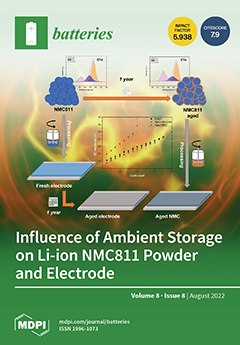We demonstrate that dispersion stability and excellent coating quality are achieved in polyethylene (PE) separators by premixing heterogeneous ceramics such as silica (SiO
2) and alumina (Al
2O
3) in an aqueous solution, without the need for functional additives such
[...] Read more.
We demonstrate that dispersion stability and excellent coating quality are achieved in polyethylene (PE) separators by premixing heterogeneous ceramics such as silica (SiO
2) and alumina (Al
2O
3) in an aqueous solution, without the need for functional additives such as dispersing agents and surfactants. Due to the opposite polarities of the zeta potentials of SiO
2 and Al
2O
3, SiO
2 forms a sheath around the Al
2O
3 surface. Electrostatic repulsion occurs between the Al
2O
3 particles encapsulated in SiO
2 to improve the dispersion stability of the slurry. The CCSs fabricated using a dual ceramic (SiO
2 and Al
2O
3)-containing aqueous coating slurry, denoted as DC-CCSs, exhibit improved physical properties, such as a wetting property, electrolyte uptake, and ionic conductivity, compared to bare PE separators and CCSs coated with a single ceramic of Al
2O
3 (SC-CCSs). Consequently, DC-CCSs exhibit an improved electrochemical performance, in terms of rate capability and cycle performance. The half cells consisting of DC-CCSs retain 93.8% (97.12 mAh g
−1) of the initial discharge capacity after 80 cycles, while the bare PE and SC-CCSs exhibit 22.5% and 26.6% capacity retention, respectively. The full cells consisting of DC-CCSs retain 90.9% (102.9 mAh g
−1) of the initial discharge capacity after 400 cycles, while the bare PE and SC-CCS exhibit 64.7% and 73.4% capacity retention, respectively.
Full article





